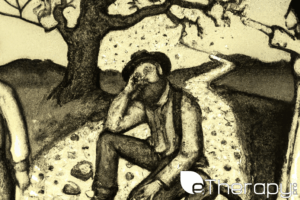
Grief and love are conjoined, you don’t get one without the other. – Jandy Nelson
At the heart of every loss is the profound sensation of grief, a feeling as deep and as vast as the love we held for what we’ve lost. The journey through grief often prompts a crucial question: Is there a ‘right’ way to grieve? This query reflects our search for guidance in one of life’s most challenging experiences. Yet, the truth about grief is its profound uniqueness. No two individuals grieve in the exact same way, just as no two loves are identical. As we embark on this exploration of grief, remember that it is a path as individual as the person walking it, filled with its own turns and terrains that are for each to navigate in their way.
Grief can be a disorienting and overwhelming experience, yet it is also a deeply personal and transformative one. It challenges our notions of normalcy and invites us to find strength and understanding in our own unique experiences. As we delve into the nature of grief, we aim to offer insights and strategies that acknowledge and respect this deeply personal journey, providing support and guidance for those traversing this complex emotional landscape.
Understanding the Five Stages of Grief
Grief, a complex and deeply personal process, is often described through the lens of five stages. These stages, while a helpful framework, are not experienced uniformly by everyone.
Overview of the Five Stages
Denial: This first stage involves shock and disbelief. The reality of the loss feels overwhelming, and denial serves as a temporary buffer to the intense emotions. During this phase, individuals may struggle to accept the truth, often feeling numb or disconnected from their emotions and surroundings.
Anger: As the masking effects of denial start to fade, the pain re-emerges. Anger may manifest as resentment, frustration, or irritation, either directed at others, oneself, or the situation. It can be a way to channel and release the accumulated emotional pain and helplessness associated with the loss.
Bargaining: In this stage, individuals may dwell on what could have been done differently to prevent the loss or alleviate the pain. This stage often involves persistent thoughts about alternate realities or outcomes, accompanied by feelings of guilt or regret for things said or left unsaid.
Depression: As the magnitude of the loss sinks in, it’s common to feel profound sadness, despair, and emptiness. It’s a period of processing and acknowledgment of the reality of the loss. People may withdraw from life, feel a deep sense of loneliness, and reflect on what has been lost.
Acceptance: This final stage is about accepting the reality of the loss and recognizing that this new reality is the permanent reality. It doesn’t mean being okay with the loss but rather coming to terms with it. Acceptance often brings a more calm and stable emotional state, allowing individuals to start moving forward and finding ways to live with the loss.
Flexibility of the Stages
It’s important to understand that these stages are not linear or prescriptive. People may experience them in different orders, revisit certain stages, or not experience all stages. Each person’s journey through grief is unique, and these stages are merely a guide to understanding the myriad of emotions and reactions one might encounter during the grieving process.
Your Grief, Your Journey
Grief is a deeply personal experience, and there is no universal blueprint for navigating it. This section will discuss the individuality of grief and provide examples of how different people might grieve in their own unique ways.
There’s No Right Way to Grieve
It’s important to acknowledge that there is no ‘right’ or ‘wrong’ way to grieve. Grief does not follow a set timeline or pattern. While some might find solace in sharing their feelings and memories, others may prefer solitude. Some individuals find themselves cycling through intense emotions rapidly, while others may experience a more steady, lingering sense of loss. The key is to allow yourself the space and time to grieve in a way that feels right for you, without feeling pressured to conform to certain expectations or timelines.
Examples of Personal Grieving Processes
Consider the example of Maya, who lost a close friend. She finds comfort in writing letters to her friend, expressing feelings and sharing updates about her life. This personal ritual helps Maya feel connected to her friend.
In contrast, David, who grieved the loss of his pet, found solace in creating a photo album celebrating the pet’s life. This process allowed him to revisit happy memories and gradually come to terms with his loss.
These examples illustrate that grief is a unique journey for each person. Whether it’s through writing, creating, reflecting, or even engaging in physical activity, each person finds their own path through the complex landscape of loss.
Practical Ways to Cope with Grief
Navigating through the terrain of grief can be challenging, but certain strategies can offer support and guidance. This section delves into practical techniques from Cognitive Behavioral Therapy (CBT), the importance of seeking support, and the necessity of embracing emotions during the grieving process.
Strategies from CBT
Cognitive Behavioral Therapy (CBT) provides valuable approaches to manage the complexities of grief:
- Scheduled Grieving: Allocating a specific time each day for grieving can help manage overwhelming emotions, allowing for a structured expression of feelings.
- Purposeful Activities: Engaging in activities or hobbies that are meaningful or enjoyable can offer a sense of normalcy and a break from grief.
- Continuing Shared Projects: Carrying on with projects or plans you had with your loved one can be a way to honor their memory and feel connected to them.
- Mindfulness Practices: Techniques like mindfulness and meditation can aid in managing the intensity of emotions associated with grief, fostering a sense of calm and presence.
Finding Support
Seeking support is a crucial aspect of coping with loss. This support can come from various sources:
Family and Friends: Loved ones can provide emotional support and a listening ear.
Professional Help: Therapists, especially those accessible through platforms like eTherapyPro, can offer specialized guidance and coping strategies.
Support Groups: Connecting with others who have experienced similar losses can provide comfort and understanding.
Embracing Your Emotions
Grief encompasses a wide range of emotions, and it’s important to allow yourself to experience and express them. Whether it’s sadness, anger, or even moments of joy, acknowledging these feelings is key to healing. Writing in a journal, talking to a trusted friend, or expressing emotions through art are some ways to embrace and understand your feelings. Remember, there’s no ‘correct’ way to feel during grief, and every emotion is a valid part of the process.
Conclusion
In our journey through understanding grief, we’ve uncovered that it is a deeply personal experience with no set rules or timelines. The Five Stages of Grief provide a framework, but each individual navigates them differently. Embracing your emotions, seeking support, and employing practical strategies can greatly aid in the process. Remember, grief is not a path to be walked alone, and reaching out for help is a sign of strength, not weakness.
As you move forward, carry with you the knowledge that grief, in all its forms, is a testament to love and connection. It is a journey not just of loss, but also of profound transformation and growth.
What lies behind us and what lies before us are tiny matters compared to what lies within us. – Ralph Waldo Emerson
May this thought inspire hope and resilience, reminding you of the inner strength you possess to navigate the waves of grief.









